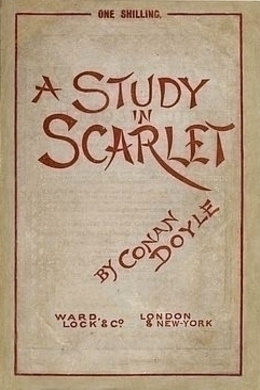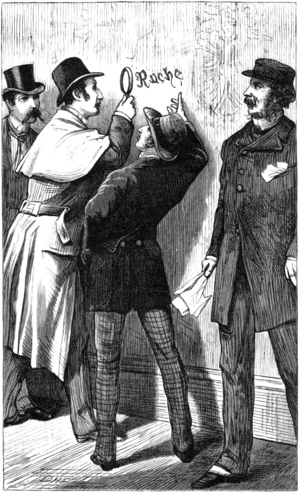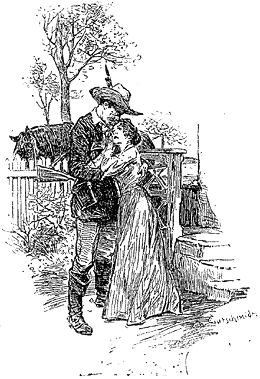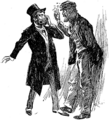A Study in Scarlet facts for kids

First edition in annual cover, 1887
|
|
| Author | Arthur Conan Doyle |
|---|---|
| Country | United Kingdom |
| Series | Sherlock Holmes |
| Genre | Detective |
| Publisher | Ward Lock & Co |
|
Publication date
|
1887 in annual (1888 in book form) |
| Followed by | The Sign of the Four |
A Study in Scarlet is an exciting detective novel written by the British author Arthur Conan Doyle. It was first published in 1887. This book is super important because it's the very first time we meet the famous detective Sherlock Holmes and his loyal friend, Dr. Watson. They quickly became one of the most well-known detective teams in all of English literature!
When the story first came out, it didn't get a lot of attention. Only a few copies of the magazine it appeared in, Beeton's Christmas Annual for 1887, are still around today, and they are worth a lot of money! Even though Conan Doyle wrote many short stories about Holmes (56 of them!), A Study in Scarlet is one of only four full-length novels in the original series. The next novel was The Sign of the Four, published in 1890. This book was also the first detective story to show a detective using a magnifying glass to look for clues.
Contents
The Story of A Study in Scarlet
Part 1: Watson's Memories
In 1881, Doctor John Watson comes back to London. He had been serving as a doctor in a war in Afghanistan. Now, he needs a place to live. An old friend tells him that Sherlock Holmes is looking for someone to share the rent for a flat at 221B Baker Street. His friend warns Watson that Holmes is a bit unusual. Holmes and Watson meet, check each other out, and decide to move in together.
Holmes works as a "consulting detective." This means people come to him for help with mysteries. Watson is amazed by Holmes's amazing deductive skills. Holmes can figure out a lot about a person just by looking at them!
One day, a telegram arrives asking Holmes for help with a murder case. Watson goes with Holmes to the crime scene. It's an empty house on Brixton Road. Two police inspectors, Gregson and Lestrade, are already there. The dead man is Enoch Drebber from Cleveland, Ohio. Papers found on him show he had a secretary named Joseph Stangerson.
On a wall, written in red, is the word "RACHE." This is a German word for "revenge." Holmes quickly figures out that this word is a trick to fool the police. He also deduces that Drebber died from poison. Holmes even gives a description of the killer! When they move Drebber's body, they find a woman's gold wedding ring.
Holmes puts ads in several newspapers about the ring. He also buys a copy of the ring. He hopes this will make the killer, who seems to have already tried to get the ring back, come out of hiding. An old woman answers the ad. She claims the ring belongs to her daughter. Holmes gives her the fake ring and follows her. But she manages to get away from him. This makes Holmes think she was helping the killer, or maybe she was the killer in disguise.
A day later, Inspector Gregson visits Holmes and Watson. He tells them he has arrested a suspect. Gregson went to Madame Charpentier's Boarding House. Drebber and Stangerson had stayed there before the murder. Drebber had behaved badly towards Mrs. Charpentier's daughter, Alice. This caused them to be kicked out right away. However, Drebber came back later that night and tried to grab Alice. Her older brother then attacked him. He tried to chase Drebber with a cudgel (a heavy stick). But he said he lost sight of Drebber. Gregson arrested him based on this evidence.
Later, Stangerson is also murdered. His body is found near his hotel window. Above it, "RACHE" is written again. Stangerson only had a novel, a pipe, a telegram saying "J.H. is in Europe," and a small box with two pills. Holmes tests the pills on an old, sick Scottish Terrier dog at Baker Street. The first pill does nothing, but the second pill kills the dog.
Then, a young street boy named Wiggins arrives. He leads the Baker Street Irregulars, a group of street children Holmes sometimes uses to help him. Wiggins has found a cab Holmes wanted. Holmes sends him to get the cab driver, pretending he needs help with his luggage. When the cab driver comes upstairs, Holmes handcuffs and holds him. The captured cab driver is Jefferson Hope, the man who murdered Drebber and Stangerson.
Part 2: The Story of Jefferson Hope
The story then goes back in time to Utah in 1847. A man named John Ferrier and a little girl named Lucy are the only survivors of a group of pioneers. They are saved by a group of Latter-day Saints led by Brigham Young. But they are only saved if they agree to join and live by the Mormon faith. Years later, in 1860, Lucy grows up and falls in love with Jefferson Hope.
However, Brigham Young says Lucy cannot marry someone outside their faith. He demands that she marry either Joseph Stangerson or Enoch Drebber. Both are sons of important church members. Ferrier, who adopted Lucy and promised never to let her marry a Mormon, sends a message to Hope.
Lucy is given one month to choose between her two suitors. Hope arrives the night before the deadline. They all try to escape in the dark. But the Mormons catch them while Hope is away hunting for food. Stangerson kills Ferrier. Lucy is forced to marry Drebber. She dies a month later from a broken heart.
Hope breaks into Drebber's house the night before Lucy's funeral. He wants to kiss her one last time and take her wedding ring. He promises to get revenge on Drebber and Stangerson. But he starts to get sick with a serious heart problem called an aortic aneurysm. This makes him leave the mountains to earn money and get better.
Years later, he returns. He learns that Drebber and Stangerson have left Salt Lake City after some disagreements within their community. Drebber is now rich from Lucy's family money, and Stangerson is his secretary. For over 20 years, Hope chases them. In Cleveland, Ohio, Hope recognizes Drebber. Drebber has Hope put in prison for a few months as a "rival in love." After being released, Hope tracks them across Europe, through France, Russia, Denmark, and finally to England.
In London, Hope becomes a cab driver. He eventually finds Drebber and Stangerson. After an argument with Madame Charpentier's son, Drebber gets into Hope's cab. Hope takes him to the empty house on Brixton Road. He forces Drebber to choose between two pills. One is harmless, and the other is poison. Drebber takes the poisoned pill. As he dies, Hope shows him Lucy's wedding ring. The excitement, along with his heart problem, makes his nose bleed. He uses the blood to write "RACHE" on the wall above Drebber. He hopes this will confuse the police.
Stangerson, when he hears about Drebber's murder, refuses to leave his hotel room. Hope climbs in through the window. He offers Stangerson the same choice of pills. However, Stangerson attacks him, and Hope has to kill him.
Hope dies from his aneurysm the night before he is supposed to appear in court. Holmes then explains to Watson how he figured out who the murderer was. In the newspapers, Inspectors Lestrade and Gregson get all the credit for solving the case. Watson is angry about this. He tells Holmes that Holmes should write down the adventure and publish it. Holmes refuses, so Watson decides to write it himself!
How the Book Was Published
Arthur Conan Doyle wrote this novel when he was 27 years old. He finished it in less than three weeks! He was a doctor in Southsea, Hampshire, and had already published some short stories in magazines like London Society. The story was first called A Tangled Skein.
After many publishers said no, it was finally published by Ward, Lock & Co. in the 1887 edition of Beeton's Christmas Annual. Conan Doyle wanted to get paid based on how many copies sold (a royalty). But instead, he was paid a single amount of £25 for all the rights to the story. That's like getting about £3,371.95 today, considering how much things cost now. The first version had drawings by David Henry Friston.
The novel was first published as a book in July 1888 by Ward, Lock & Co. This book edition had drawings by the author's father, Charles Doyle. In 1890, the first American version was released by J. B. Lippincott & Co.. Another edition came out in 1891, illustrated by George Hutchinson. A German version from 1902 had drawings by Richard Gutschmidt. Many more editions, translations into other languages, and plays have been made since then.
Other Versions of the Story
A Study in Scarlet was the first Sherlock Holmes story, so it was also one of the first to be made into movies and shows.
Movies
In 1914, Conan Doyle allowed a British silent film to be made by G. B. Samuelson. The movie was also called A Study in Scarlet. Holmes was played by James Bragington, who was an accountant and only acted this one time. He was chosen because he looked like Holmes in the original drawings. Many early silent films were made with materials that didn't last long, and keeping old films safe wasn't common back then. So, this film is now a lost film (meaning it no longer exists). The movie was popular enough that Samuelson made another film in 1916 called The Valley of Fear.
Another short silent film, also called A Study in Scarlet, came out in the United States in 1914. It was released just one day after the British film. This American film starred Francis Ford as Holmes and was not approved by Conan Doyle. It is also a lost film.
The 1933 film called A Study in Scarlet starred Reginald Owen as Holmes. This movie doesn't really follow the book's plot at all. Besides Holmes, Watson, Mrs. Hudson, and Inspector Lestrade, the only connections to the original stories are a few character names. The plot of this movie is actually very similar to a famous mystery novel written years later by Agatha Christie called And Then There Were None.
Radio Shows
Edith Meiser turned A Study in Scarlet into a four-part radio series for The Adventures of Sherlock Holmes. These episodes aired in November and December 1931. Richard Gordon played Holmes, and Leigh Lovell played Watson.
Parts of the story were mixed with another Holmes story, "The Adventure of Charles Augustus Milverton," for a radio script called "Dr Watson Meets Mr Sherlock Holmes." This was one of many radio shows featuring John Gielgud as Holmes and Ralph Richardson as Watson. It first aired on the BBC Light Programme in 1954.
The story was also adapted for the 1952–1969 BBC radio series in 1962 by Michael Hardwick. Carleton Hobbs played Holmes, and Norman Shelley played Watson.
Another British radio version aired in 1974, with Robert Powell as Holmes.
A radio play of the story aired on CBS Radio Mystery Theater in 1977.
A Study in Scarlet was adapted as the first two episodes of the BBC's full Sherlock Holmes 1989–1998 radio series. These two parts aired on Radio 4 in 1989. Clive Merrison played Holmes, and Michael Williams played Watson.
It was also adapted in 2007 for the American radio series The Classic Adventures of Sherlock Holmes.
Television Shows
The 1954–1955 television series used only the first part of the book for an episode called "The Case of the Cunningham Heritage."
The book was made into an episode that aired in 1968 for the BBC television series Sherlock Holmes. Peter Cushing played Holmes, and Nigel Stock played Dr Watson.
It was adapted as the second episode of the 1979 Soviet television film, Sherlock Holmes and Dr. Watson.
An animated television film adaptation was made in 1983 by Burbank Films Australia. Peter O'Toole was the voice of Holmes. In both the 1968 TV show and the 1983 animated version, the story is changed so that Holmes and Watson already know each other and live together.
A Study in Scarlet is one of the stories that was not adapted for the popular TV series starring Jeremy Brett as Holmes, which ran from 1984 to 1994.
Steven Moffat loosely adapted A Study in Scarlet into "A Study in Pink". This was the first episode of the 2010 BBC television series Sherlock. It stars Benedict Cumberbatch as a modern-day Sherlock Holmes and Martin Freeman as Dr Watson. This version keeps many ideas from the book, like the word "RACHE" and the two pills. However, the whole backstory about America is left out, and the killer's reason for revenge is totally different. The special episode "The Abominable Bride" also shows Holmes and Watson meeting in a Victorian setting.
"The Deductionist," an episode of Elementary, uses many ideas from Hope's case, including the idea of revenge. The story was more closely adapted in a later episode called "A Study in Charlotte."
"The First Adventure," the first episode of the 2014 NHK puppet series Sherlock Holmes, is loosely based on A Study in Scarlet. In this show, Holmes, Watson, and Lestrade are students at a boarding school. They discover that a student named Jefferson Hope got revenge on two other students for stealing his watch. The show's opening song, "Scarlet Story," is named after the novel.
Other Media
A Study in Scarlet was made into a comic book by Seymour Moskowitz for Classics Illustrated in 1953. It was also adapted into graphic novels by Innovation Publishing in 1969 and by Sterling Publishing in 2010.
In 2014, A Study in Scarlet was adapted for the stage (a play) by Greg Freeman, Lila Whelan, and Annabelle Brown for Tacit Theatre. It first showed in London in March 2014.
In February 2019, a new play version called "Sherlock Holmes and the Scarlet Avenger" was put on in Nuremberg, PA.
In June 2022, Pitlochry Festival Theatre will put on a new play version called "Sherlock Holmes; A Study in Lipstick, Ketchup and Blood." It will be performed outdoors by two actors.
Images for kids








